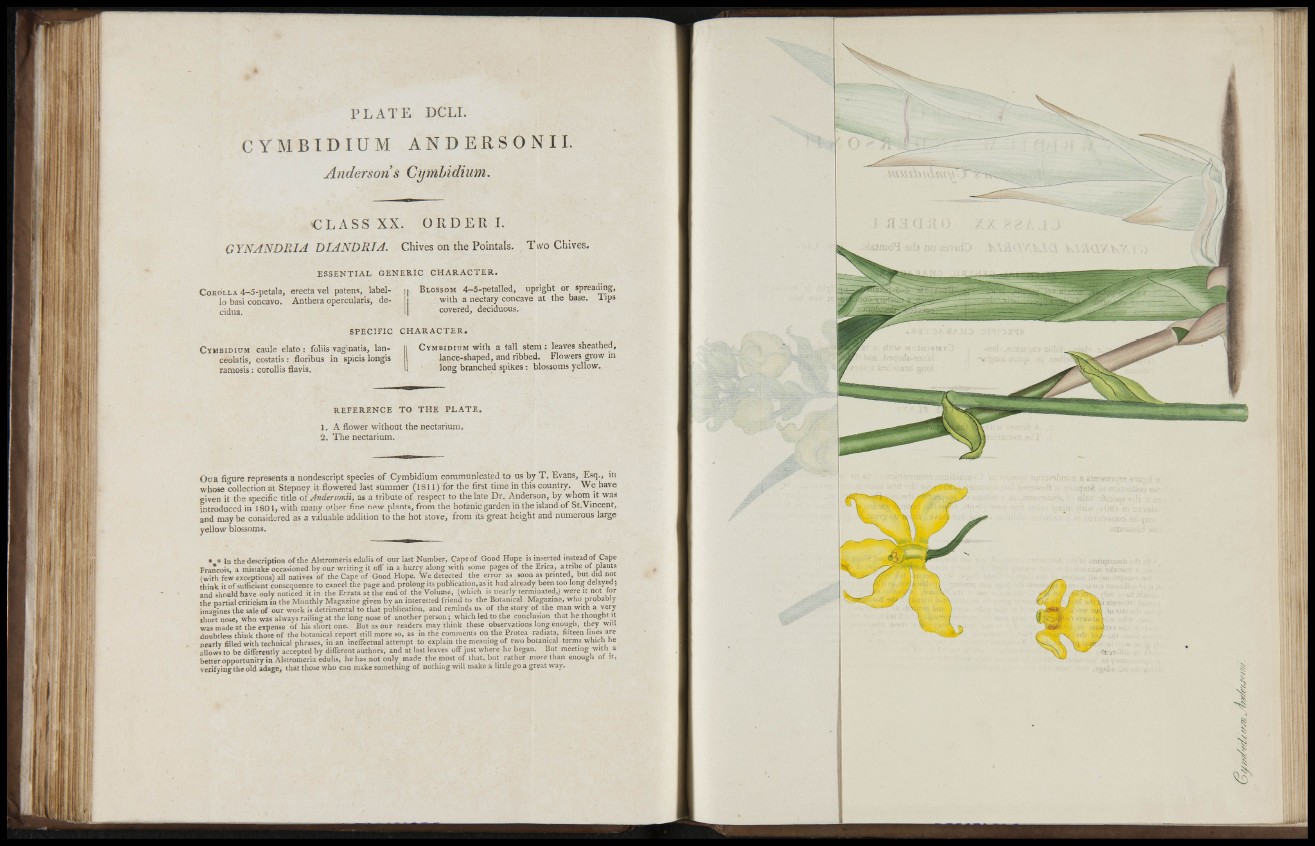
P L A T E DCLI.
C Y M B I D I U M A N D E R S O N 11.
Anderson s Cymhidium.
5 '
CLASS XX. ORDER I.
CYNANDRIA DIANDIUA. Chives on the Pointals. Two Chives.
E S S E N T I A L GENERIC CHARACTER.
COROLLA 4-5-petala, erecta vel patens, label-
Io basi concavo. Anthera operculariSj decidua.
BLOSSOM 4-5-petaned, upright or spreading,
w i t h a nectary concave at the base. Tips
covered, deciduous.
S P E C I F I C CHARACTER.
C Y M B I D I U M caule elato ; foliis vaginalis, lanceolatis,
costatis : floribus in spicis longis
ramosis ; corollis flavis.
C Y M B I D I U M with a tall stem: leaves sheathed,
l a n c e - s h a p e d , and ribbed. Flowers grow iii
long branched spikes: blossoms yellow.
R E F E R E N C E TO THE PLATE.
1. A flower without the nectariuni.
2 . The nectarium.
OuB ficure represents a nondescript species of Cymbidium communicated to us by T . Evans, Esq., ni
whose collection at Stepney it flowered last summe r (1811) for the first time in this country. We have
given it the specific title oi JndeTSonii, as a tribute of respect to the late Dr . Anderson, by whom it was
i n t r o d u c e d in 1801, with many other fine new plants, f rom the botanic garden in the island of St.Vmcent,
and may be considered as a valuable addition to the hot stove, from its great height and numerous large
y e l l ow blossoms.
?! <
* the description of the Alstromeriaedulis of our last Number, Cape of Good Hope is inserted instead of Cape
Francois, a mistake occasioned by our writing it off in a hurry along willi some pages of the Erica, a tribe of plants
(with few exceptions) all natives of the Cape of Good Hope. We detected the error as soon as printed but did not
think it of sufficient consequence to cancel the page and prolong its publication, as it had already been too long delayed;
and should have only noticed it in the Errata at the end of the Volume, (which is nearly terminated,) were it not tor
the partial criticism in the Monthly Magazine given by an interested friend to the Botanical Magazine, who probably
imagines the sale of our work is detrimental to that publication, and reminds us of the story of the man with a very
ihort nose, who was always railing at the long nose of another person ; which led to the conclusion that he thought it
was made at the expense of his short one. But as our readers may think these observations long enough, they will
doubtless think those of the botanical report still more so, as in the comments on the Protea radiata, fifteen lines are
nearly filled with technical phrases, iu an ineffectual attempt to explain the meaning of two botanical terms which he
allows to be differently accepted by different authors, and at last leaves off just where he began. But meeting with^ a
better opportunity in Alstromeria eduUs, he has not only made the most of that, but rather more than enough of it.
verifying the old adage, that those who can make something of nothing will make a little go a great way.
rj!i.
I
•i.
!i IS
!! •
iniiiWI!
i i ' f i
'i'l.iSi!
•Mi m
s
I